Integration of the Chimp Optimization Algorithm and Rule-Based Energy Management Strategy for Enhanced Microgrid Performance Considering Energy Trading Pattern
Abstract
1. Introduction
1.1. Literature Review
1.2. Research Contributions
- Integration of a and BAT energy storage systems within a grid-connected microgrid, which includes photovoltaic (PV), wind turbine (WT), electrolyzer (ELZ), FC, and BAT storage.
- Implementation of the ChOA for optimal power distribution across different MG sources.
- A comparative analysis demonstrating the efficiency of the ChOA, showing results against three other optimization techniques: the Salp Swarm Algorithm (SSA), Grey Wolf Optimization (GWO), and Genetic Algorithm (GA).
- Determination of optimal sizes of the optimization parameters related to the microgrid components, which include PV, WT, FC, ELZ, tank, and BAT units.
2. Materials and Methods
2.1. Modelling of Photovoltaic System
2.2. WT System Model
2.3. Modelling of Hydrogen Fuel Cell
2.4. Modelling of Battery Storage
2.5. Modeling of Grid Inverter
2.6. Energy Management System
| Algorithm 1 REMS for ToU-ToU plan |
| Inputs:, SOC of the energy storage system, SOH in the HST. Outputs: Schedule of power sharing among the RES, hydrogen storage, battery units, and the main grid. for (each time interval (t)) do using Ir(t), T(t), VW if The ToUsell price is high then The load should be supplied, and then the extra to the grid, then charge the BAT, then charge the hydrogen storage tank. else The load should be supplied, then charge the BAT, charge hydrogen tank, and the excess to the grid. end if else if the TOUbuy price is high The load should be supplied first, then release BAT energy, supply hydrogen fuel cell, and then buy shortfall power from the grid. else Load should be supplied first, then buy the shortfall power from the grid, release BAT energy, supply hydrogen to fuel cell. end if end if end for |
3. Formulation of Optimization Problem
3.1. Objective Function
3.1.1. Annual Cost of System
3.1.2. Levelized Cost of Energy
3.2. Optimization Constraint
- SOC:
- 2.
- A set of limitations governs the electrolyzer (ELZ) capacity, the in the storage tank (HST), the state of (SoH) in the tank, and the electrical power delivered by the FC, as specified in the following equations:
4. Chimp Optimization Algorithm
5. Simulation Results
5.1. Optimization Results
5.2. Seasonal Variability of Energy Sources and Contributions
5.3. Analysis of Power Production and Demand
5.4. Analysis of Energy Trade: Purchases and Sales
6. Conclusions
Author Contributions
Funding
Data Availability Statement
Conflicts of Interest
Nomenclature
| Battery cycle count | Battery discharging power | ||
| BAT | Battery | Battery capacity | |
| CS | Cuckoo search | Battery dissipation factor | |
| Battery degradation cost | State of charge of battery | ||
| ELZ | Electrolyzer | Minimum state of charge | |
| GA | Genetic algorithm | Maximum state of charge | |
| GAMS | General algebraic modeling system | Battery charging efficiency | |
| HS | Harmony Search | Battery discharging efficiency | |
| MILP | Mix integer linear programming | Electrolyzer rating | |
| MNLP | Mix non-linear programming | Fuel cell rating | |
| NSGA-II | Non-dominated sorting GA | Hydrogen tank rating | |
| SOH | State of hydrogen | Photovoltaic rating | |
| Inverter efficiency | Wind turbine rating | ||
| Number of hydrogen tanks | Photovoltaic power | ||
| Maximum battery power | PSO | Particle swarm optimization | |
| Inverter output power | Power storage | ||
| Maximum battery power | PV | Photovoltaic | |
| Total load | Wind turbine power | ||
| ∆t | Time step | SoC | State of charge |
| Fuel cell efficiency | Maximum state of charge | ||
| Hydrogen tank efficiency | Minimum state of charge | ||
| Hydrogen stored energy | Operating cell temperature | ||
| Electrolyzer output power | V | Speed | |
| Grid power | Cut in speed | ||
| Battery charging power | Cut out speed | ||
| Power from HT to FC | Rated speed |
References
- Espoir, D.K.; Sunge, R.; Bannor, F. Economic growth, renewable and nonrenewable electricity consumption: Fresh evidence from a panel sample of African countries. Energy Nexus 2023, 9, 100165. [Google Scholar] [CrossRef]
- Wankouo Ngouleu, C.A.; Koholé, Y.W.; Fohagui, F.C.V.; Tchuen, G. Optimal sizing and techno-enviro-economic evaluation of a hybrid photovoltaic/wind/diesel system with battery and fuel cell storage devices under different climatic conditions in Cameroon. J. Clean. Prod. 2023, 423, 138753. [Google Scholar] [CrossRef]
- Hamza, M.F.; Modu, B. A bibliometric analysis on renewable energy microgrids integrating hydrogen storage: Strategies for optimal sizing and energy management. Sci. Afr. 2025, 27, e02609. [Google Scholar] [CrossRef]
- Aliyu, A.K.; Modu, B.; Tan, C.W. A review of renewable energy development in Africa: A focus in South Africa, Egypt and Nigeria. Renew. Sustain. Energy Rev. 2018, 81, 2502–2518. [Google Scholar] [CrossRef]
- Al-Sharafi, A.; Sahin, A.Z.; Ayar, T.; Yilbas, B.S. Techno-economic analysis and optimization of solar and wind energy systems for power generation and hydrogen production in Saudi Arabia. Renew. Sustain. Energy Rev. 2017, 69, 33–49. [Google Scholar] [CrossRef]
- Wankouo Ngouleu, C.A.; Koholé, Y.W.; Fohagui, F.C.V.; Tchuen, G. Techno-economic analysis and optimal sizing of a battery-based and hydrogen-based standalone photovoltaic/wind hybrid system for rural electrification in Cameroon based on meta-heuristic techniques. Energy Convers. Manag. 2023, 280, 116794. [Google Scholar] [CrossRef]
- Samy, M.; Barakat, S.; Ramadan, H. A flower pollination optimization algorithm for an off-grid PV-Fuel cell hybrid renewable system. Int. J. Hydrogen Energy 2019, 44, 2141–2152. [Google Scholar] [CrossRef]
- Argyrou, M.C.; Christodoulides, P.; Kalogirou, S.A. Energy storage for electricity generation and related processes: Technologies appraisal and grid scale applications. Renew. Sustain. Energy Rev. 2018, 94, 804–821. [Google Scholar] [CrossRef]
- Li, Y.; Shang, Z.; Peng, F.; Zhao, Y.; Ren, L. Improved control-oriented polarization characteristic modeling for proton exchange membrane water electrolyzer with adaptive hunting game based metaheuristic optimization. Energy Convers. Manag. 2024, 305, 118264. [Google Scholar] [CrossRef]
- Müller, L.A.; Leonard, A.; Trotter, P.A.; Hirmer, S. Green hydrogen production and use in low- and middle-income countries: A least-cost geospatial modelling approach applied to Kenya. Appl. Energy 2023, 343, 121219. [Google Scholar] [CrossRef]
- Elkadeem, M.; Kotb, K.M.; Ullah, Z.; Atiya, E.G.; Dán, A.; Wang, S. A two-stage multi-attribute analysis method for city-integrated hybrid mini-grid design. Sustain. Cities Soc. 2021, 65, 102603. [Google Scholar] [CrossRef]
- Modu, B.; Abdullah, M.P.; Alkassem, A.; Hamza, M.F. Optimal rule-based energy management and sizing of a grid-connected renewable energy microgrid with hybrid storage using Levy Flight Algorithm. Energy Nexus 2024, 16, 100333. [Google Scholar] [CrossRef]
- Modu, B.; Abdullah, M.P.; Alkassem, A.; Bukar, A.L.; Zainal, N.H. Operational Strategy of a Hybrid Renewable Energy System With Hydrogen-Battery Storage for Optimal Performance Using Levy Flight Algorithm. In Proceedings of the 2023 IEEE Conference on Energy Conversion (CENCON), Kuching, Malaysia, 23–24 October 2023; pp. 35–40. [Google Scholar]
- Modu, B.; Abdullah, M.P.; AlKassem, A.; Hamza, M.F.; Bukar, A.L. The role of hybrid hydrogen-battery storage in a grid-connected renewable energy microgrid considering time-of-use electricity tariffs. J. Energy Storage 2025, 105, 114729. [Google Scholar] [CrossRef]
- Modu, B.; Abdullah, M.P.; Bukar, A.L.; Hamza, M.F.; Adewolu, M.S. Operational strategy and capacity optimization of standalone solar-wind-biomass-fuel cell energy system using hybrid LF-SSA algorithms. Int. J. Hydrogen Energy 2024, 50, 92–106. [Google Scholar] [CrossRef]
- Bukar, A.L.; Tan, C.W.; Yiew, L.K.; Ayop, R.; Tan, W.-S. A rule-based energy management scheme for long-term optimal capacity planning of grid-independent microgrid optimized by multi-objective grasshopper optimization algorithm. Energy Convers. Manag. 2020, 221, 113161. [Google Scholar] [CrossRef]
- Mahmoudi, S.M.; Maleki, A.; Ochbelagh, D.R. Optimization of a hybrid energy system with/without considering back-up system by a new technique based on fuzzy logic controller. Energy Convers. Manag. 2021, 229, 113723. [Google Scholar] [CrossRef]
- Moafi, M.; Ardeshiri, R.R.; Mudiyanselage, M.W.; Marzband, M.; Abusorrah, A.; Rawa, M.; Guerrero, J.M. Optimal coalition formation and maximum profit allocation for distributed energy resources in smart grids based on cooperative game theory. Int. J. Electr. Power Energy Syst. 2023, 144, 108492. [Google Scholar] [CrossRef]
- Petrucci, A.; Barone, G.; Buonomano, A.; Athienitis, A. Modelling of a multi-stage energy management control routine for energy demand forecasting, flexibility, and optimization of smart communities using a Recurrent Neural Network. Energy Convers. Manag. 2022, 268, 115995. [Google Scholar] [CrossRef]
- Samy, M.; Almamlook, R.E.; Elkhouly, H.I.; Barakat, S. Decision-making and optimal design of green energy system based on statistical methods and artificial neural network approaches. Sustain. Cities Soc. 2022, 84, 104015. [Google Scholar] [CrossRef]
- Güven, A.F.; Yörükeren, N.; Samy, M.M. Design optimization of a stand-alone green energy system of university campus based on Jaya-Harmony Search and Ant Colony Optimization algorithms approaches. Energy 2022, 253, 124089. [Google Scholar] [CrossRef]
- Mokhtara, C.; Negrou, B.; Settou, N.; Bouferrouk, A.; Yao, Y. Design optimization of grid-connected PV-Hydrogen for energy prosumers considering sector-coupling paradigm: Case study of a university building in Algeria. Int. J. Hydrogen Energy 2021, 46, 37564–37582. [Google Scholar] [CrossRef]
- Alshammari, N.; Asumadu, J. Optimum unit sizing of hybrid renewable energy system utilizing harmony search, Jaya and particle swarm optimization algorithms. Sustain. Cities Soc. 2020, 60, 102255. [Google Scholar] [CrossRef]
- Djouahi, A.; Negrou, B.; Rouabah, B.; Mahboub, A.; Samy, M.M. Optimal sizing of battery and super-capacitor based on the MOPSO technique via a new FC-HEV application. Energies 2023, 16, 3902. [Google Scholar] [CrossRef]
- Djouahi, A.; Negrou, B.; Touggui, Y.; Samy, M.M. Optimal sizing and thermal control in a fuel cell hybrid electric vehicle via FC-HEV application. J. Braz. Soc. Mech. Sci. Eng. 2023, 45, 533. [Google Scholar] [CrossRef]
- Koholé, Y.W.; Fohagui, F.C.V.; Wankouo Ngouleu, C.A.; Tchuen, G. An effective sizing and sensitivity analysis of a hybrid renewable energy system for household, multi-media and rural healthcare centres power supply: A case study of Kaele, Cameroon. Int. J. Hydrogen Energy 2024, 49, 1321–1359. [Google Scholar] [CrossRef]
- Bukar, A.L.; Tan, C.W.; Lau, K.Y. Optimal sizing of an autonomous photovoltaic/wind/battery/diesel generator microgrid using grasshopper optimization algorithm. Sol. Energy 2019, 188, 685–696. [Google Scholar] [CrossRef]
- Bakht, M.P.; Salam, Z.; Gul, M.; Anjum, W.; Kamaruddin, M.A.; Khan, N.; Bukar, A.L. The Potential Role of Hybrid Renewable Energy System for Grid Intermittency Problem: A Techno-Economic Optimisation and Comparative Analysis. Sustainability 2022, 14, 14045. [Google Scholar] [CrossRef]
- Babatunde, O.M.; Munda, J.L.; Hamam, Y. Hybridized off-grid fuel cell/wind/solar PV/battery for energy generation in a small household: A multi-criteria perspective. Int. J. Hydrogen Energy 2022, 47, 6437–6452. [Google Scholar] [CrossRef]
- Babatunde, O.M.; Munda, J.L.; Hamam, Y. Off-grid hybrid photovoltaic—Micro wind turbine renewable energy system with hydrogen and battery storage: Effects of sun tracking technologies. Energy Convers. Manag. 2022, 255, 115335. [Google Scholar] [CrossRef]
- Martsinchyk, K.; Martsinchyk, A.; Łazor, M.; Shuhayeu, P.; Kupecki, J.; Niemczyk, A.; Błesznowski, M.; Milewski, J. Feasibility study and techno-economic assessment of power-to-gas (P2G) technology based on solid oxide electrolysis (SOE). J. Environ. Manag. 2024, 354, 120425. [Google Scholar] [CrossRef]
- Ren, Y.; Jin, K.; Gong, C.; Hu, J.; Liu, D.; Jing, X.; Zhang, K. Modelling and capacity allocation optimization of a combined pumped storage/wind/photovoltaic/hydrogen production system based on the consumption of surplus wind and photovoltaics and reduction of hydrogen production cost. Energy Convers. Manag. 2023, 296, 117662. [Google Scholar] [CrossRef]
- Ghaem Sigarchian, S.; Malmquist, A.; Martin, V. Design optimization of a small-scale polygeneration energy system in different climate zones in Iran. Energies 2018, 11, 1115. [Google Scholar] [CrossRef]
- Guo, E.; He, B.; Zhang, J. Effects of photovoltaic panel type on optimum sizing of an electrical energy storage system using a stochastic optimization approach. J. Energy Storage 2023, 72, 108581. [Google Scholar] [CrossRef]
- El Hassani, S.; Oueslati, F.; Horma, O.; Santana, D.; Moussaoui, M.A.; Mezrhab, A. Techno-economic feasibility and performance analysis of an islanded hybrid renewable energy system with hydrogen storage in Morocco. J. Energy Storage 2023, 68, 107853. [Google Scholar] [CrossRef]
- Awan, A.B.; Zubair, M.; Sidhu, G.A.S.; Bhatti, A.R.; Abo-Khalil, A.G. Performance analysis of various hybrid renewable energy systems using battery, hydrogen, and pumped hydro-based storage units. Int. J. Energy Res. 2019, 43, 6296–6321. [Google Scholar] [CrossRef]
- Le, T.S.; Nguyen, T.N.; Bui, D.-K.; Ngo, T.D. Optimal sizing of renewable energy storage: A techno-economic analysis of hydrogen, battery and hybrid systems considering degradation and seasonal storage. Appl. Energy 2023, 336, 120817. [Google Scholar] [CrossRef]
- Mellouk, L.; Ghazi, M.; Aaroud, A.; Boulmalf, M.; Benhaddou, D.; Zine-Dine, K. Design and energy management optimization for hybrid renewable energy system- case study: Laayoune region. Renew. Energy 2019, 139, 621–634. [Google Scholar] [CrossRef]
- Restrepo, M.; Cañizares, C.A.; Simpson-Porco, J.W.; Su, P.; Taruc, J. Optimization- and Rule-based Energy Management Systems at the Canadian Renewable Energy Laboratory microgrid facility. Appl. Energy 2021, 290, 116760. [Google Scholar] [CrossRef]
- Mohandes, B.; Wahbah, M.; Moursi, M.S.E.; El-Fouly, T.H.M. Renewable Energy Management System: Optimum Design and Hourly Dispatch. IEEE Trans. Sustain. Energy 2021, 12, 1615–1628. [Google Scholar] [CrossRef]
- Alzahrani, A. Energy Management and Optimization of a Standalone Renewable Energy System in Rural Areas of the Najran Province. Sustainability 2023, 15, 8020. [Google Scholar] [CrossRef]
- Tran, H.G.; Ton-That, L.; Thao, N.G.M. Lagrange Multiplier-Based Optimization for Hybrid Energy Management System with Renewable Energy Sources and Electric Vehicles. Electronics 2023, 12, 4513. [Google Scholar] [CrossRef]
- Torkan, R.; Ilinca, A.; Ghorbanzadeh, M. A genetic algorithm optimization approach for smart energy management of microgrids. Renew. Energy 2022, 197, 852–863. [Google Scholar] [CrossRef]
- Barukčić, M.; Varga, T.; Benšić, T.; Jerković Štil, V. Optimal Allocation of Renewable Energy Sources and Battery Storage Systems Considering Energy Management System Optimization Based on Fuzzy Inference. Energies 2022, 15, 6884. [Google Scholar] [CrossRef]
- Rao, C.K.; Sahoo, S.K.; Yanine, F.F. Intelligent power management system for optimizing load strategies in renewable generation. Electr. Eng. 2025, 107, 3039–3061. [Google Scholar] [CrossRef]
- Zeng, J.; Wang, Q.; Liu, J.; Chen, J.; Chen, H. A Potential Game Approach to Distributed Operational Optimization for Microgrid Energy Management With Renewable Energy and Demand Response. IEEE Trans. Ind. Electron. 2019, 66, 4479–4489. [Google Scholar] [CrossRef]
- Fernandez, E.; Hossain, M.J.; Mahmud, K.; Nizami, M.S.H.; Kashif, M. A Bi-level optimization-based community energy management system for optimal energy sharing and trading among peers. J. Clean. Prod. 2021, 279, 123254. [Google Scholar] [CrossRef]
- Maleki, A.; Pourfayaz, F.; Ahmadi, M.H. Design of a cost-effective wind/photovoltaic/hydrogen energy system for supplying a desalination unit by a heuristic approach. Sol. Energy 2016, 139, 666–675. [Google Scholar] [CrossRef]
- Singh, A.; Baredar, P. Techno-economic assessment of a solar PV, fuel cell, and biomass gasifier hybrid energy system. Energy Rep. 2016, 2, 254–260. [Google Scholar] [CrossRef]
- Hosseinalizadeh, R.; Shakouri, H.; Amalnick, M.S.; Taghipour, P. Economic sizing of a hybrid (PV–WT–FC) renewable energy system (HRES) for stand-alone usages by an optimization-simulation model: Case study of Iran. Renew. Sustain. Energy Rev. 2016, 54, 139–150. [Google Scholar] [CrossRef]
- Singh, A.; Baredar, P.; Gupta, B. Techno-economic feasibility analysis of hydrogen fuel cell and solar photovoltaic hybrid renewable energy system for academic research building. Energy Convers. Manag. 2017, 145, 398–414. [Google Scholar] [CrossRef]
- Maleki, A. Design and optimization of autonomous solar-wind-reverse osmosis desalination systems coupling battery and hydrogen energy storage by an improved bee algorithm. Desalination 2018, 435, 221–234. [Google Scholar] [CrossRef]
- Khan, F.A.; Pal, N.; Saeed, S.H. Review of solar photovoltaic and wind hybrid energy systems for sizing strategies optimization techniques and cost analysis methodologies. Renew. Sustain. Energy Rev. 2018, 92, 937–947. [Google Scholar] [CrossRef]
- Ramli, M.A.M.; Bouchekara, H.R.E.H.; Alghamdi, A.S. Optimal sizing of PV/wind/diesel hybrid microgrid system using multi-objective self-adaptive differential evolution algorithm. Renew. Energy 2018, 121, 400–411. [Google Scholar] [CrossRef]
- Felseghi, R.-A.; Carcadea, E.; Raboaca, M.S.; Trufin, C.N.; Filote, C. Hydrogen fuel cell technology for the sustainable future of stationary applications. Energies 2019, 12, 4593. [Google Scholar] [CrossRef]
- Kaur, M.; Pal, K. Review on hydrogen storage materials and methods from an electrochemical viewpoint. J. Energy Storage 2019, 23, 234–249. [Google Scholar] [CrossRef]
- Luta, D.N.; Raji, A.K. Optimal sizing of hybrid fuel cell-supercapacitor storage system for off-grid renewable applications. Energy 2019, 166, 530–540. [Google Scholar] [CrossRef]
- Ghenai, C.; Bettayeb, M. Modelling and performance analysis of a stand-alone hybrid solar PV/Fuel Cell/Diesel Generator power system for university building. Energy 2019, 171, 180–189. [Google Scholar] [CrossRef]
- Xu, C.; Ke, Y.; Li, Y.; Chu, H.; Wu, Y. Data-driven configuration optimization of an off-grid wind/PV/hydrogen system based on modified NSGA-II and CRITIC-TOPSIS. Energy Convers. Manag. 2020, 215, 112892. [Google Scholar] [CrossRef]
- Ghenai, C.; Salameh, T.; Merabet, A. Technico-economic analysis of off grid solar PV/Fuel cell energy system for residential community in desert region. Int. J. Hydrogen Energy 2020, 45, 11460–11470. [Google Scholar] [CrossRef]
- Samy, M.M.; Barakat, S.; Ramadan, H.S. Techno-economic analysis for rustic electrification in Egypt using multi-source renewable energy based on PV/wind/FC. Int. J. Hydrogen Energy 2020, 45, 11471–11483. [Google Scholar] [CrossRef]
- Hakimi, S.M.; Hasankhani, A.; Shafie-khah, M.; Catalão, J.P.S. Optimal sizing and siting of smart microgrid components under high renewables penetration considering demand response. IET Renew. Power Gener. 2019, 13, 1809–1822. [Google Scholar] [CrossRef]
- Samy, M.M.; Sarhan, H.H.; Barakat, S.; Al-Ghamdi, S.A. A Hybrid PV-Biomass Generation Based Micro-Grid for the Irrigation System of a Major Land Reclamation Project in Kingdom of Saudi Arabia (KSA)—Case Study of Albaha Area. In Proceedings of the 2018 IEEE International Conference on Environment and Electrical Engineering and 2018 IEEE Industrial and Commercial Power Systems Europe (EEEIC/I&CPS Europe), Palermo, Italy, 12–15 June 2018; pp. 1–8. [Google Scholar]
- Bukar, A.L.; Chaitusaney, S.; Kawabe, K. Optimal energy management and techno-economic assessment of hydrogen energy production system incorporated with photovoltaic and battery storage. Int. J. Hydrogen Energy 2024, 62, 1139–1153. [Google Scholar] [CrossRef]
- Abdulkadir, M.; Bukar, A.; Modu, B. Mppt-based control algorithm for PV system using iteration-PSO under irregular shadow conditions. Arid Zone J. Eng.-Technol. Environ. 2017, 13, 97–110. [Google Scholar]
- Modu, B.; Abdullah, M.P.B.; Alkassem, A.; Garni, H.Z.A.; Alkabi, M. Optimal Design of a Grid-Independent Solar-Fuel Cell-Biomass Energy System Using an Enhanced Salp Swarm Algorithm Considering Rule-Based Energy Management Strategy. IEEE Access 2024, 12, 23914–23929. [Google Scholar] [CrossRef]
- Koholé, Y.W.; Fohagui, F.C.V.; Djiela, R.H.T.; Tchuen, G. Wind energy potential assessment for co-generation of electricity and hydrogen in the far North region of Cameroon. Energy Convers. Manag. 2023, 279, 116765. [Google Scholar] [CrossRef]
- Modu, B.; Abdullah, M.P.; Bukar, A.L.; Hamza, M.F. A systematic review of hybrid renewable energy systems with hydrogen storage: Sizing, optimization, and energy management strategy. Int. J. Hydrogen Energy 2023, 48, 38354–38373. [Google Scholar] [CrossRef]
- Modu, B.; Abdullah, M.P.; Bukar, A.L.; Hamza, M.F.; Adewolu, M.S. Energy management and capacity planning of photovoltaic-wind-biomass energy system considering hydrogen-battery storage. J. Energy Storage 2023, 73, 109294. [Google Scholar] [CrossRef]
- Yousri, D.; Farag, H.E.Z.; Zeineldin, H.; El-Saadany, E.F. Integrated model for optimal energy management and demand response of microgrids considering hybrid hydrogen-battery storage systems. Energy Convers. Manag. 2023, 280, 116809. [Google Scholar] [CrossRef]
- Trifkovic, M.; Sheikhzadeh, M.; Nigim, K.; Daoutidis, P. Modeling and control of a renewable hybrid energy system with hydrogen storage. IEEE Trans. Control Syst. Technol. 2013, 22, 169–179. [Google Scholar] [CrossRef]
- Yodwong, B.; Guilbert, D.; Phattanasak, M.; Kaewmanee, W.; Hinaje, M.; Vitale, G. Faraday’s efficiency modeling of a proton exchange membrane electrolyzer based on experimental data. Energies 2020, 13, 4792. [Google Scholar] [CrossRef]
- Sun, H.; Ebadi, A.G.; Toughani, M.; Nowdeh, S.A.; Naderipour, A.; Abdullah, A. Designing framework of hybrid photovoltaic-biowaste energy system with hydrogen storage considering economic and technical indices using whale optimization algorithm. Energy 2022, 238, 121555. [Google Scholar] [CrossRef]
- Armijo, J.; Philibert, C. Flexible production of green hydrogen and ammonia from variable solar and wind energy: Case study of Chile and Argentina. Int. J. Hydrogen Energy 2020, 45, 1541–1558. [Google Scholar] [CrossRef]
- Bukar, A.L.; Chaitusaney, S.; Kawabe, K. Optimal design of on-site PV-based battery grid-tied green hydrogen production system. Energy Convers. Manag. 2024, 307, 118378. [Google Scholar] [CrossRef]
- Khishe, M.; Mosavi, M.R. Chimp optimization algorithm. Expert Syst. Appl. 2020, 149, 113338. [Google Scholar] [CrossRef]
- Khishe, M.; Nezhadshahbodaghi, M.; Mosavi, M.R.; Martín, D. A Weighted Chimp Optimization Algorithm. IEEE Access 2021, 9, 158508–158539. [Google Scholar] [CrossRef]
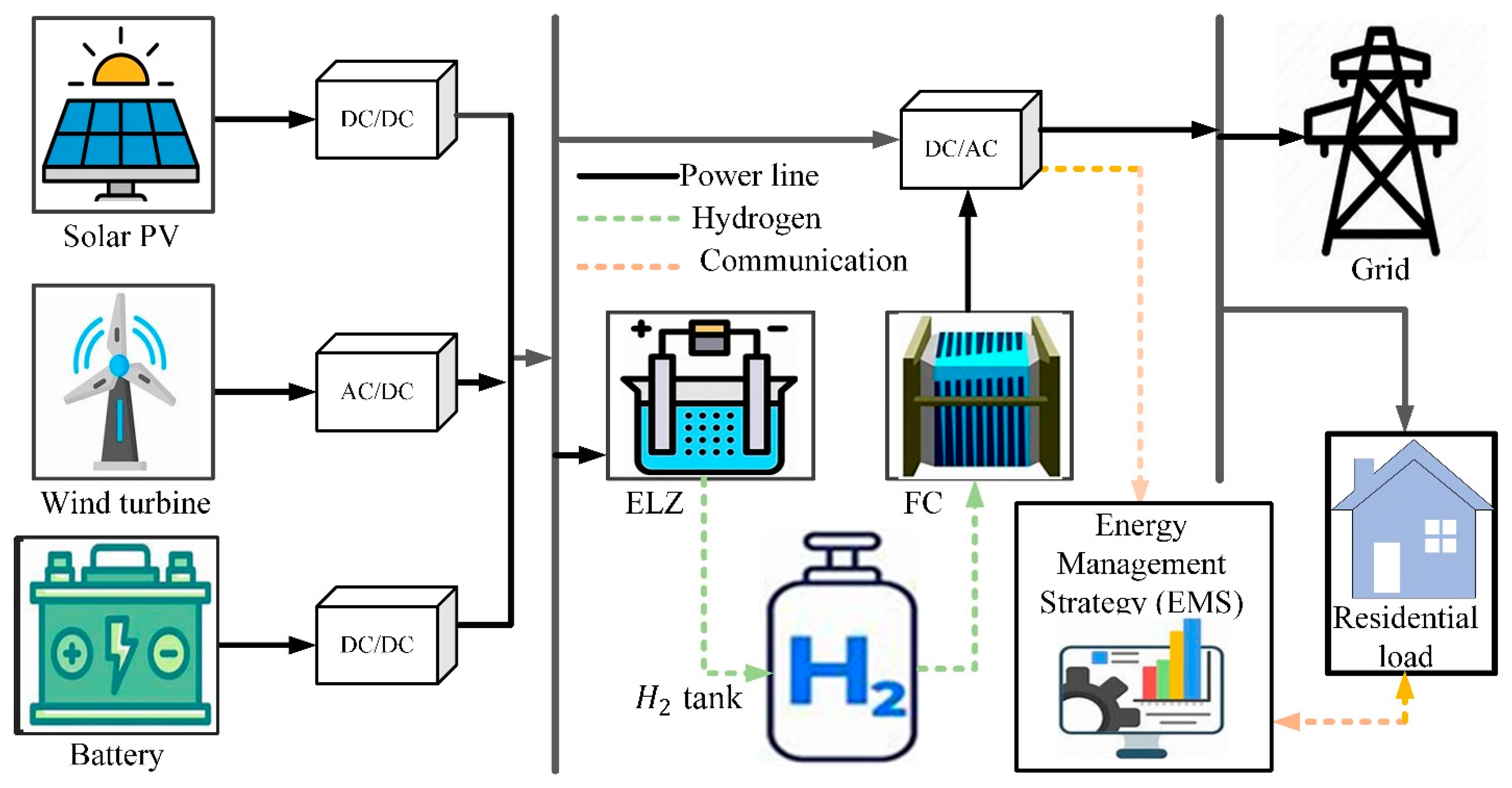

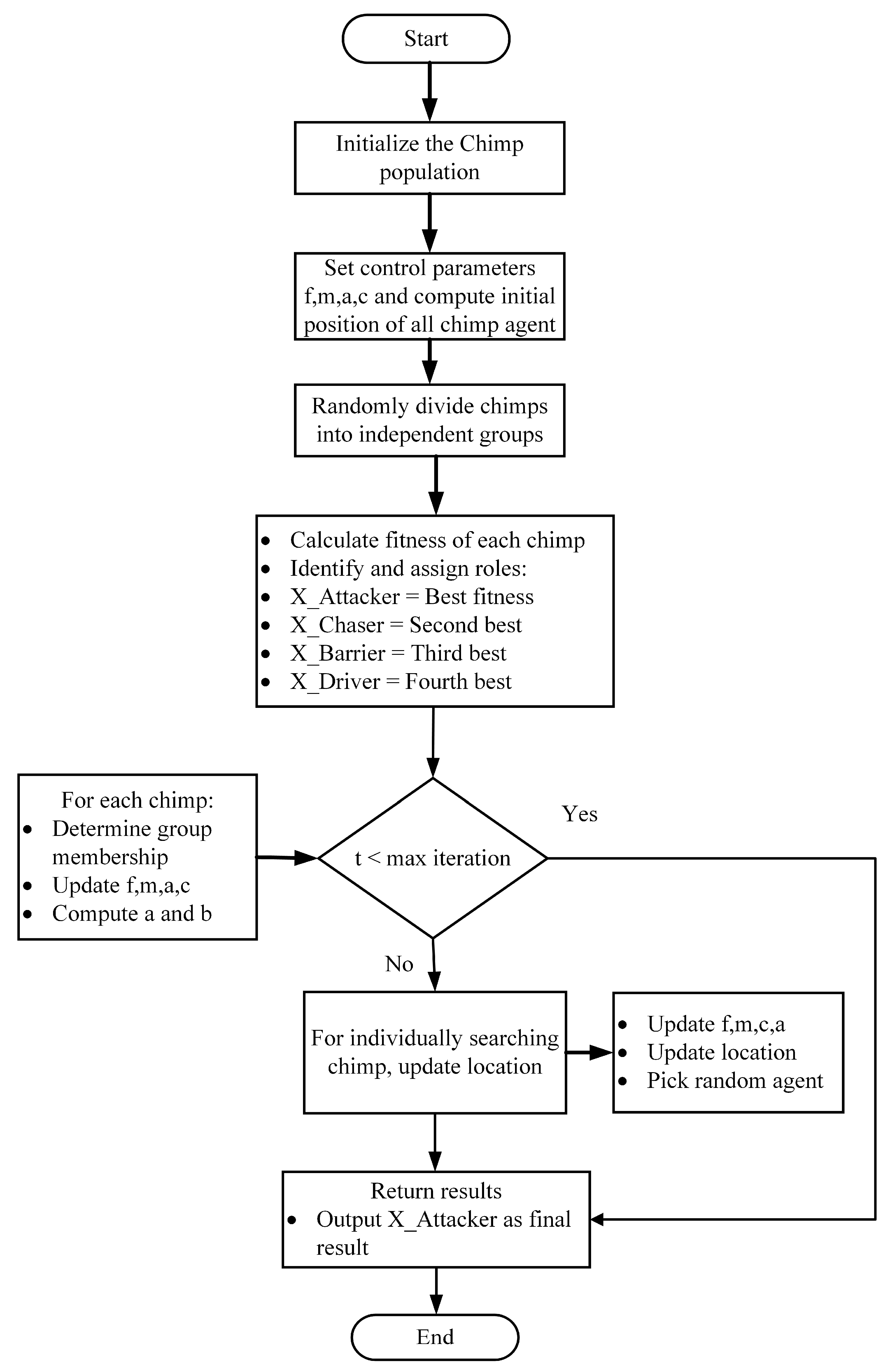
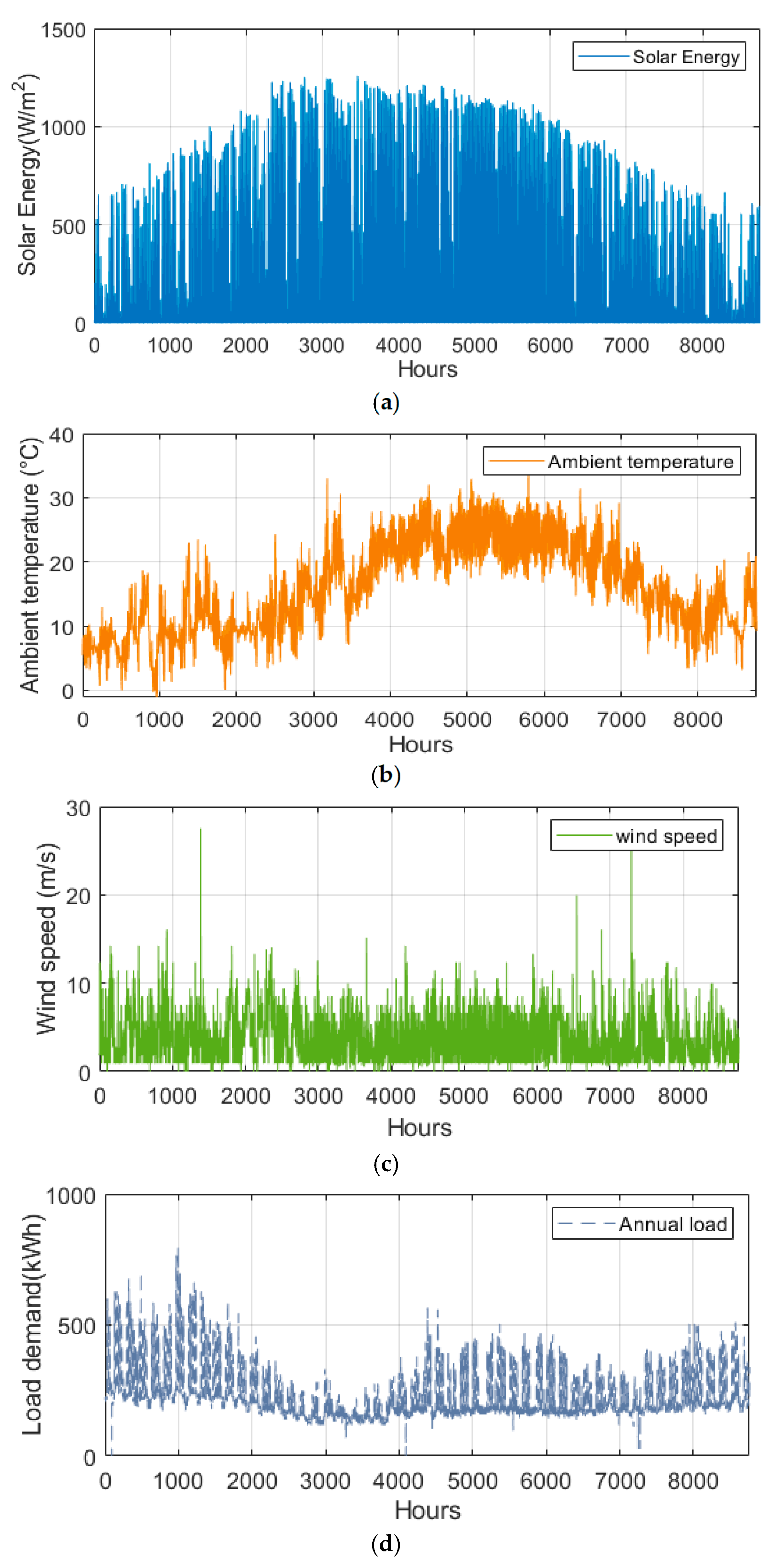



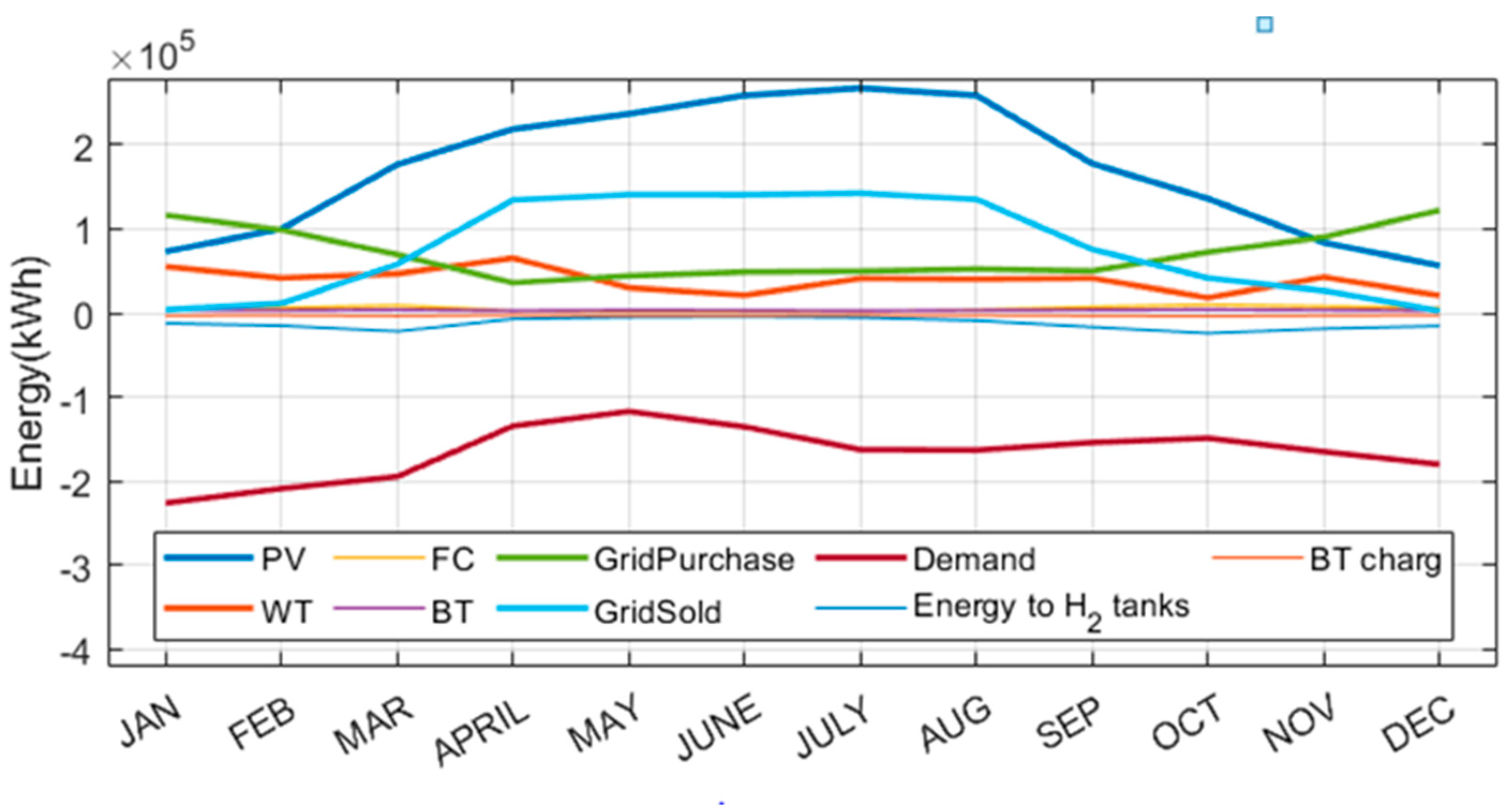

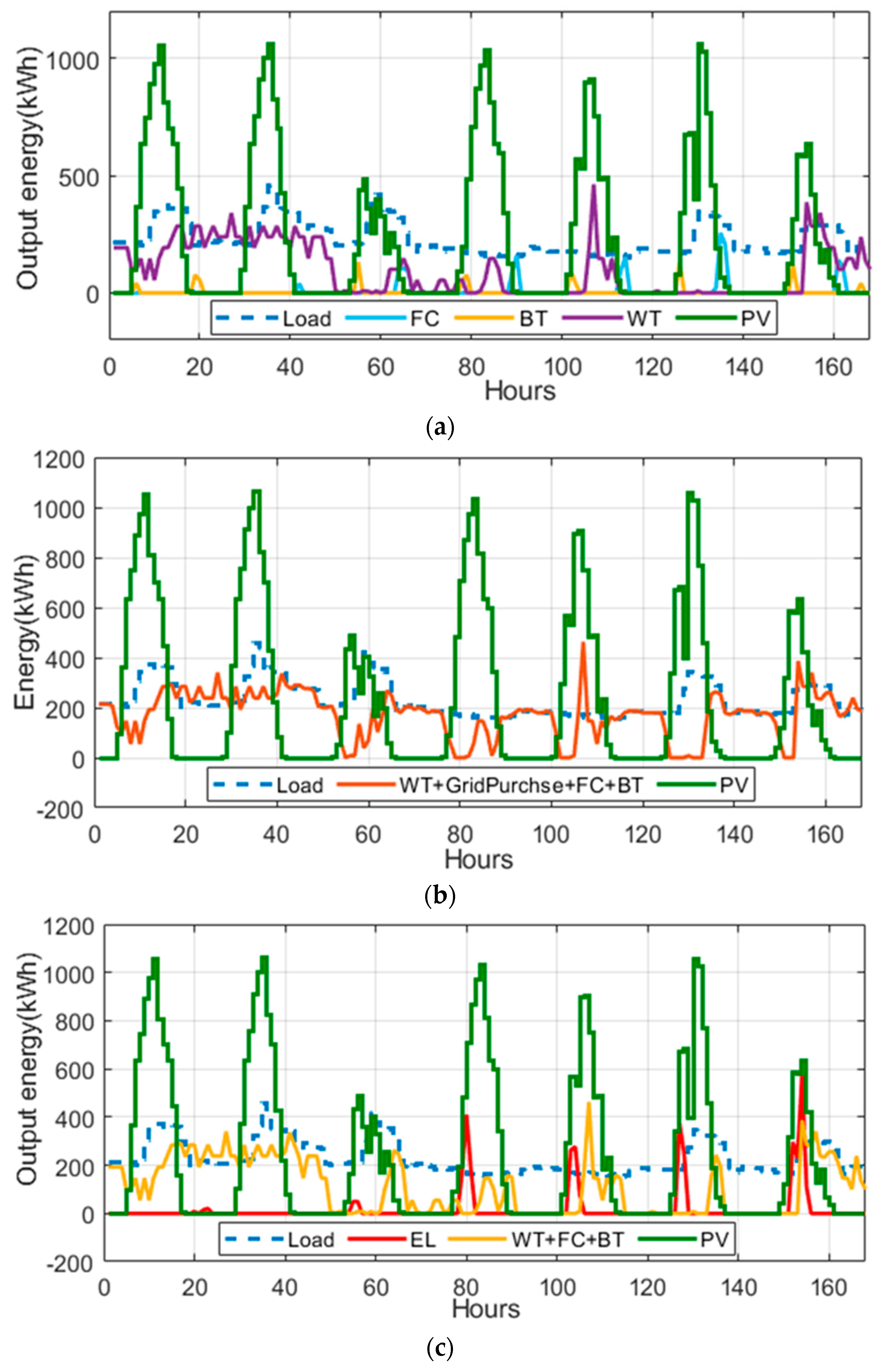

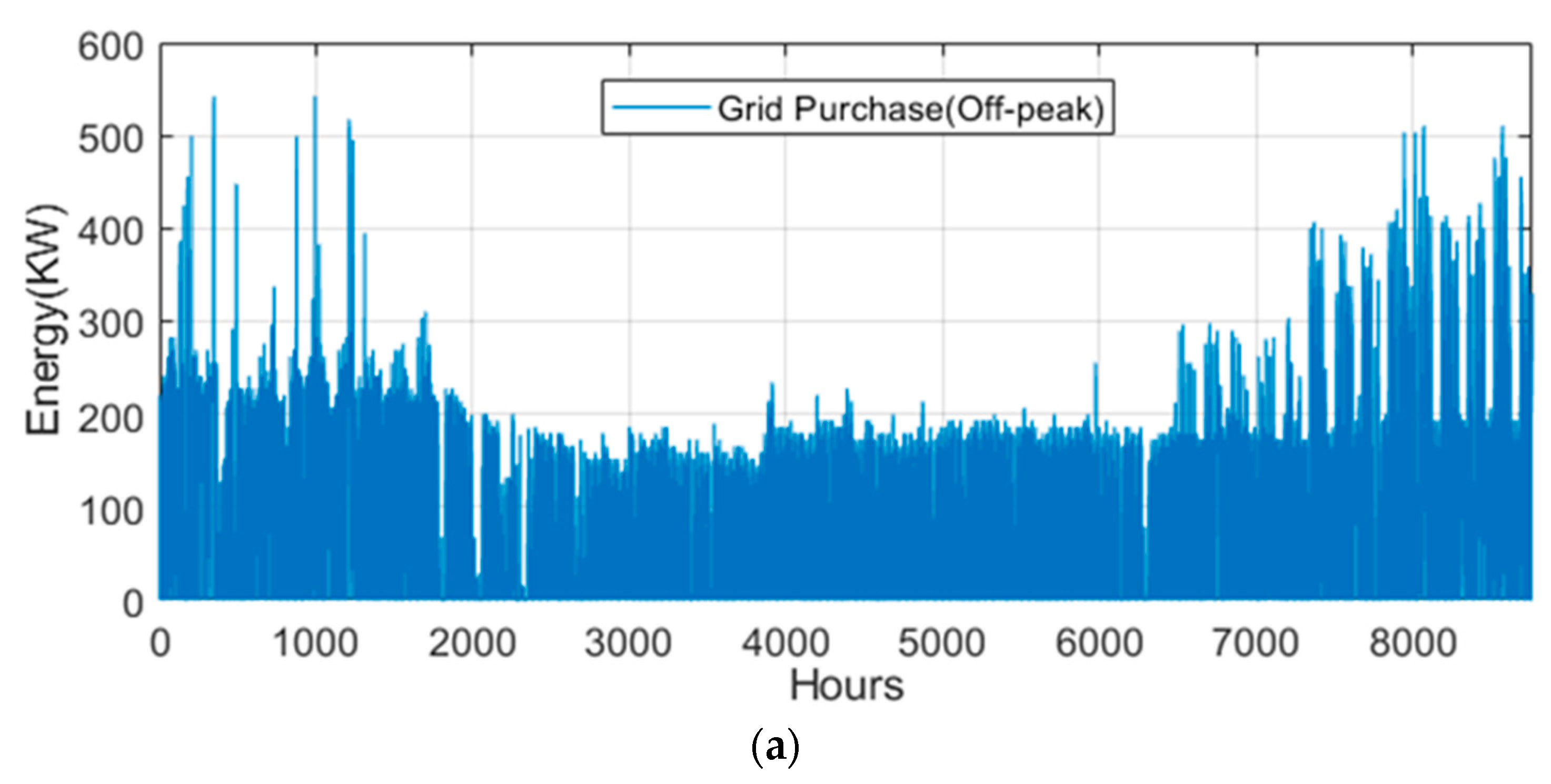
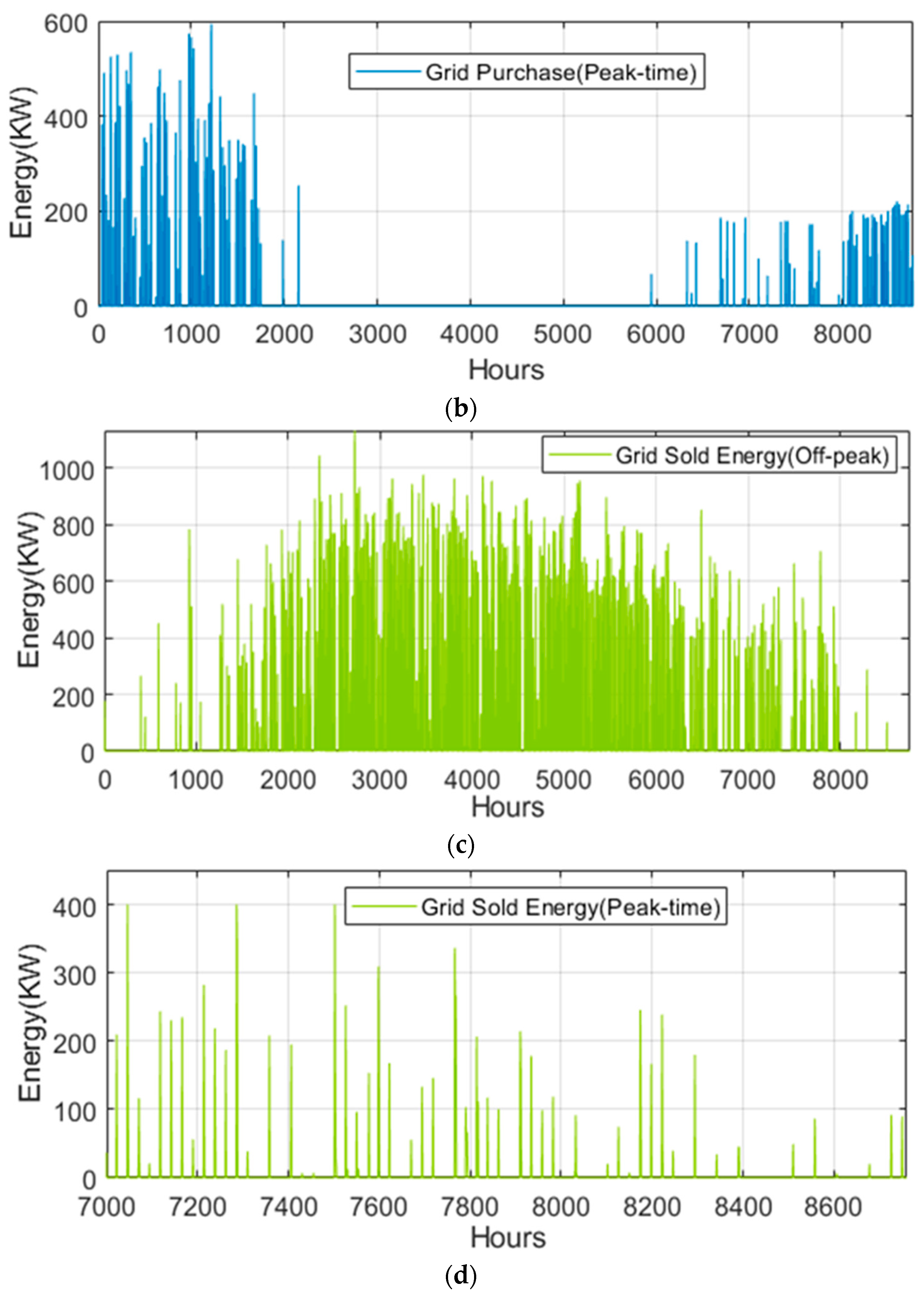
| S/N | Ref. | Year | Citations | Scope and Constraint |
|---|---|---|---|---|
| 1 | [48] | 2016 | 227 | The study did not account for sensitivity analysis on key metric variations, including component costs, efficiency rates, and weather fluctuations. |
| 2 | [49] | 2016 | 138 | There is provision to view, alter, or introduce a mathematical model (black box) in HOMER. |
| 3 | [50] | 2016 | 321 | The financial analysis relies on specific cost assumptions that may not be universally applicable and could vary over time. |
| 4 | [51] | 2017 | 272 | The study employs a specific load demand model, which does not account for variations and uncertainties in real-world energy consumption. |
| 5 | [52] | 2018 | 297 | The study’s fundamental assumptions did not account for metrics like maintenance costs, component degradation, and fluctuations in energy costs. |
| 6 | [53] | 2018 | 237 | The approaches for assessing reliability and evaluating costs, which are essential for validating techno-economic feasibility, are not provided. |
| 7 | [54] | 2018 | 257 | There is provision to view, alter, or introduce a mathematical model (black box) in HOMER. |
| 8 | [55] | 2019 | 376 | Challenges related to the regulatory framework, energy policymakers, and potential stakeholders. |
| 9 | [56] | 2019 | 170 | Absence of a thorough comparative breakdown, with cost, accessibility, and environmental effects of the materials. |
| 10 | [57] | 2019 | 144 | There is no provision to view, alter, or introduce a mathematical model (black box) in HOMER. |
| 11 | [58] | 2019 | 214 | The reliability of the results can be affected by the assumptions made for the components, like effectiveness, degradation charges, and operational constraints. |
| 12 | [59] | 2020 | 333 | The optimization model does not account for fluctuations in load demand and renewable energy generation. |
| 13 | [60] | 2020 | 370 | Assuming a steady load demand might not accurately represent real-world fluctuations in residential energy consumption. |
| 14 | [61] | 2020 | 190 | Initial cost assumptions affect the economic assessment and funding options. |
| 15 | [62] | 2021 | 188 | The real-time application can be affected by the complexity of the algorithm. |
| Component | Parameters | Values | Unit |
|---|---|---|---|
| Photovoltaic (PV) | at STC | 1 | kW |
| 48 ± 2 | °C | ||
| 1/°C | |||
| 16.9 | % | ||
| Wind turbine (WT) | 1 | kW | |
| 2.5 | m/s | ||
| 20 | m/s | ||
| 9.5 | m/s | ||
| Electrolyser | 1 | kW | |
| 75 | % | ||
| Hydrogen tank | 1 | kg | |
| Heating value | 39.72 | kWh/kg | |
| Minimum pressure | 3 | bar | |
| Maximum pressure | 28 | bar | |
| Fuel cell | 1 | kW | |
| 60 | % | ||
| Battery | 5 | Years | |
| 45.2 | kWh | ||
| DOD | 70 | % | |
| 80/20 | % | ||
| 0.85 | % | ||
| 250 | Ah | ||
| 25 | Year | ||
| 4 | % | ||
| Inverter | 92 | % |
| 1. Initialize Parameters: |
| Define the initial chimp population . |
| {where fm = the movement coefficient representing the impact factor of each chimp in the search process; a = the convergence parameter controlling exploration and exploitation balance; c = the influence coefficient simulating the social behavior in the hunt.} |
| Compute the initial position for all the chimp agent |
| Randomly divide the chimp population into independent groups |
| Until stopping condition is satisfied |
| 2. Evaluate Initial Fitness: |
| Calculate the fitness of each chimp agent in the population. |
| Identify and assign roles: |
| Second − best solution |
| Third − best solution. |
| 3. Begin Iterations: |
| Repeat until a stopping condition (e.g., max iterations) is met |
| For each chimp, determine its group membership. |
| Update using group approach, |
| Compute a and d using |
| end for |
| for individually search chimp |
| Update the location of the present search agent |
| Pick arbitrary search agent |
| end if |
| Update the location of the present search |
| end if |
| end for |
| Update f, m, a, and c |
| Update , , and |
| 4. Return Results: |
| output , the best solution found, as the final result. |
| Algorithm | Population | Number of Iterations | Additional Parameters |
|---|---|---|---|
| ChOA | n = 40 | T = 100 | Distribution index β = 1.5; λ = 1; coefficient of social force α = 1; control parameter for flexibility μ = 1 |
| SSA | n = 40 | T = 100 | Step size control factor a = 0.01 |
| GA | n = 40 | T = 100 | Crossover distribution index: 20; mutation index: 20; crossover probability: 0.8; mutation probability: 0.2 |
| GWO | n = 40 | T = 100 | Alpha, beta, and delta coefficients; the wolf chasing approach directed by alpha |
| Optimization Method | PV (kW) | WT (kW) | BAT (kWh) | ELZ (kW) | FC (kW) | COE ($) | ASC ($) | |
|---|---|---|---|---|---|---|---|---|
| ChOA | 1360 | 462 | 164 | 138 | 571 | 381 | 0.272 | 544,422 |
| SSA | 1363 | 542 | 167 | 141 | 574 | 411 | 0.275 | 544,834 |
| GA | 1356 | 554 | 166 | 139 | 572 | 407 | 0.274 | 544,612 |
| GWO | 1358 | 546 | 165 | 239 | 572 | 409 | 0.276 | 545,130 |
Disclaimer/Publisher’s Note: The statements, opinions and data contained in all publications are solely those of the individual author(s) and contributor(s) and not of MDPI and/or the editor(s). MDPI and/or the editor(s) disclaim responsibility for any injury to people or property resulting from any ideas, methods, instructions or products referred to in the content. |
© 2025 by the authors. Licensee MDPI, Basel, Switzerland. This article is an open access article distributed under the terms and conditions of the Creative Commons Attribution (CC BY) license (https://creativecommons.org/licenses/by/4.0/).
Share and Cite
Hamza, M.F.; Modu, B.; Almutairi, S.Z. Integration of the Chimp Optimization Algorithm and Rule-Based Energy Management Strategy for Enhanced Microgrid Performance Considering Energy Trading Pattern. Electronics 2025, 14, 2037. https://doi.org/10.3390/electronics14102037
Hamza MF, Modu B, Almutairi SZ. Integration of the Chimp Optimization Algorithm and Rule-Based Energy Management Strategy for Enhanced Microgrid Performance Considering Energy Trading Pattern. Electronics. 2025; 14(10):2037. https://doi.org/10.3390/electronics14102037
Chicago/Turabian StyleHamza, Mukhtar Fatihu, Babangida Modu, and Sulaiman Z. Almutairi. 2025. "Integration of the Chimp Optimization Algorithm and Rule-Based Energy Management Strategy for Enhanced Microgrid Performance Considering Energy Trading Pattern" Electronics 14, no. 10: 2037. https://doi.org/10.3390/electronics14102037
APA StyleHamza, M. F., Modu, B., & Almutairi, S. Z. (2025). Integration of the Chimp Optimization Algorithm and Rule-Based Energy Management Strategy for Enhanced Microgrid Performance Considering Energy Trading Pattern. Electronics, 14(10), 2037. https://doi.org/10.3390/electronics14102037






